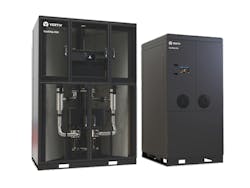Vertiv Prepares for Future of Air and Liquid Cooling, Taps Compass Datacenters as Key Partner
The Vertiv CoolPhase Flex might well be the first packaged system to provide a seamless integration of liquid cooling and refrigerant-based air-cooling technologies.
This new offering from Vertiv merges both methods into a single, compact unit that has the flexibility to meet the changing requirements of next-generation data centers.
The platform's ability to efficiently move between air and liquid cooling as operational demands shift gives the data center operator an important tool in meeting their sustainability goals.
Collaboration
Designed in partnership with Compass Datacenters, the Vertiv CoolPhase Flex platform demonstrates that the industry will be most effective in addressing sustainability demands by collaborative efforts that allow each participant to focus on their core skills.
Compass, known for building cutting-edge data center campuses, wanted a system that could rapidly transition between cooling modes.
Vertiv turned this need into reality, creating a solution that supports the necessary range of IT workloads while still optimizing for energy efficiency and cost-effectiveness across that range.
About the collaboration, Giordano Albertazzi, CEO of Vertiv, said:
AI is not only bringing change to data centers, it is also changing how key industry players work together to enable growth. Data center operators, customers, chip manufacturers, infrastructure providers, utility companies and others must work together to innovate and reduce barriers to AI adoption. Compass Datacenters and Vertiv engineers worked together to make this important project a reality.
Meeting the Challenges of AI and High-Density Computing
Not every data center has the luxury of being designed around a single task. Even the latest in AI-focused facilities should consider other potential workloads the data center should be able to accommodate.
While there might not be an immediate need to support legacy IT applications while accommodating the demands of AI and high-performance computing (HPC), individually or simultaneously, the flexibility to do so is a win for the data center.
And consider that AI workloads, often characterized by their need for extremes of power and cooling, demand sophisticated environmental control solutions capable of scaling efficiently.
The CoolPhase Flex combination system addresses potential issues by providing for:
- Flexible Cooling Modes: Initially deployed as a direct expansion (DX) air-cooling system, the unit can seamlessly transition to liquid cooling as computational density increases. This adaptability ensures operators are always prepared for future needs without requiring significant retrofits.
- Integrated Economization: The system’s air-cooling mode leverages pumped refrigerant economization (PRE) technology, which switches to free cooling when external conditions are favorable. This feature ensures maximum efficiency while minimizing energy consumption.
- Designed to Support Mixed IT Loads: By combining air and liquid cooling within the same infrastructure, the system caters to a mix of traditional and high-density computing, which, especially in a hybrid-use data center, can help maximize energy and cooling efficiencies.
- Scalability for AI Growth: Liquid cooling capabilities allow for rapid adaptation to such growth, supporting processors with high thermal demands. The combination of cooling technologies should allow for proper levels of provisioning of the cooling capacities as the infrastructure demand increases or decreases over time.
- Predictive Maintenance: Through the integration of Vertiv’s Next Predict platform, the system employs predictive analytics to shift from reactive to proactive maintenance. By analyzing historical and real-time operational data, it predicts potential issues, reducing downtime and maintenance costs.
The unit also features a self-contained, external design. It is not a traditional chilled water loop, being a packaged unit. This architecture has the benefit of eliminating many complexities, resulting in faster deployment, lower costs, and reduced downtime.
The adoption of this cooling technology represents more than a technological achievement. It clearly delineates the importance in technology leaders collaborating to address their pressing challenges.
Vertiv and Compass Datacenters jointly developed the system, leveraging their respective expertise in infrastructure solutions and data center operations.
Chris Crosby, CEO of Compass, emphasized the importance of the partnership, pointing out that Vertiv took their vision for a future in which they could be prepared to quickly deploy air or liquid cooling to meet changing customer requirements and delivered a solution:
Our customers are looking for fast, practical and energy-efficient ways to introduce liquid cooling to support AI and other high-density applications, but want the flexibility to leverage air-cooling and support mixed loads in those same facilities. We had a vision for a future in which we could be prepared to quickly deploy air or liquid cooling to meet changing customer requirements and Vertiv brought that vision to life in a very innovative way. The Vertiv CoolPhase Flex provides a level of flexibility that is unparalleled in the marketplace and that is highly valuable to us and to our customers.
Real-World Deployment
As AI adoption accelerates, the demands for sustainability and energy efficiency will drive future partnerships between data center operators, equipment manufacturers, and other stakeholders.
The first CoolPhase Flex units are scheduled for deployment at a Compass facility in the first quarter of 2025. This rollout is part of a multi-year, multi-billion-dollar supply agreement between Vertiv and Compass. By reducing energy usage and enabling more sustainable operations, the agreement and deployment aligns with the industry’s push toward greener infrastructure.
As AI and HPC continue to evolve, the need for innovative solutions and collaborative efforts will only grow. By addressing the challenges of scalability, efficiency, and flexibility, this system ensures that data centers have the flexibility to address the rapidly changing demands presented by new technologies and applications.
Vertiv Unveils Two High-Capacity CDUs to Support Data Center AI
Probably not coincidentally, one day after the company's CoolPhase Flex announcements with Compass Datacenters last month, Vertiv on Nov. 19 announced a significant expansion of its global liquid cooling portfolio capabilities, with the launch of a pair of new, high-capacity coolant distribution unit (CDU) systems to support data center AI applications.
To wit, the new Vertiv CoolChip CDU liquid-to-liquid and liquid-to-air systems support hyperscale, colocation and enterprise applications. The new CDU systems enable modular, cost-effective liquid cooling deployments in data centers, making it possible to operate high-density computing for AI alongside traditional air-cooled racks, notes the company.
Launched at SC24 (November 19 - 22), the new Vertiv CoolChip CDU family furnishes much-needed flexibility to data centers and colocation providers, with capability for fast, modular growth. The flexibility to support multiple high-density racks from a single CDU supports the increasing demand operators are experiencing for AI deployments.
The new CDU systems all benefit from Vertiv's broad suite of global service offerings to support the deployment of liquid cooled infrastructure. These range from solution design, to installation, to on-going lifecycle and fluid management.
John Niemann, Senior Vice President of the thermal business unit at Vertiv, remarked:
The AI-focused data center necessitates advanced cooling technologies. Vertiv's expanded liquid-cooled solutions support the densification of the data center we are seeing as a result of AI. Our liquid cooling portfolio, complemented by our full solution of air cooling, heat rejection, and re-use solutions and global services capability, enables both new and existing data centers to seamlessly introduce liquid cooling as part of the overall hybrid cooling solution to make AI deployments easier, faster and more cost-effective for customers.
Technical Notes
The Vertiv CoolChip CDU 2300kW model is a liquid-to-liquid system that offers the most compact footprint in its capacity range, with the smaller cabinet enabling it to be placed in the row or in a mechanical gallery outside of the data center whitespace.
Offering 2.3 MW of cooling capacity, this design caters to hyperscalers and colocation providers looking to deploy large scale liquid cooling solutions at the highest density.
This system has the industry’s highest CDU capacity per square foot, contends Vertiv, enabling operators to reduce cost and footprint by deploying fewer CDUs.
For its part, the Vertiv CoolChip CDU 350kW model is a liquid-to-air system that offers direct-to-chip liquid cooling support with air-based heat rejection. These qualities enable the system to easily retrofit into existing facilities, and allows operators to deploy liquid cooling for direct-to-chip applications without a facility chilled water system.
Both Vertiv CoolChip CDU systems can distribute coolant directly to liquid cooled chips and rear-door heat exchangers. Controls allow for fluctuating temperature and flow to match varying application demands.
The systems also leverage unit-to-unit communication for system-level control; redundant power feeds, pumps and filters for improved cooling availability; remote temperature, humidity and leak detection sensors; and integrated controls that enable remote monitoring and management.
Vertiv Forecasts Top 5 Data Center Trends for 2025
Finally last month, in the context of its product and partnership announcements, Vertiv issued its listing of the top five data center trends for next year, focused on how AI continues to reshape the industry.
In 2025, Vertiv predicts that data center industry efforts to support, enable, leverage and regulate AI will engender innovation in powering and cooling AI racks, as well as better management of energy consumption and emissions.
Vertiv experts further anticipate increased industry innovation and integration to support high-density computing, as well as increased regulatory scrutiny around AI, and increasing focus on sustainability and cybersecurity efforts.
More or less directly quoted, the top 5 trends most likely to emerge across the data center industry in 2025, according to Vertiv experts, are as follows:
1. Power and cooling infrastructure innovates to keep pace with computing densification: In 2025, the company expects that the impact of compute-intense workloads will intensify, with the industry managing the sudden change in a variety of ways. Advanced computing will continue to shift from CPU to GPU to leverage the latter’s parallel computing power and the higher thermal design point of modern chips. This will further stress existing power and cooling systems and push data center operators toward cold-plate and immersion cooling solutions that remove heat at the rack level. Enterprise data centers will be impacted by this trend, as AI use expands beyond early cloud and colocation providers.
Other Vertiv 2025 predictions in the area of data center power and cooling infrastructure include the following:
- AI racks will require UPS systems, batteries, power distribution equipment and switchgear with higher power densities to handle AI loads that can fluctuate from a 10% idle to a 150% overload in a flash.
- Hybrid cooling systems, with liquid-to-liquid, liquid-to-air and liquid-to-refrigerant configurations, will evolve in rackmount, perimeter and row-based cabinet models that can be deployed in brown/greenfield applications.
- Liquid cooling systems will increasingly be paired with their own dedicated, high-density UPS systems to provide continuous operation.
- Servers will increasingly be integrated with the infrastructure needed to support them, including factory-integrated liquid cooling, ultimately making manufacturing and assembly more efficient, deployment faster, equipment footprint smaller, and increasing system energy efficiency.
2. Data centers prioritize energy availability challenges: Vertiv notes that overextended grids and skyrocketing power demands are changing how data centers consume power. Globally, the company points out that data centers use an average of 1-2% of the world’s power, but AI is driving increases in consumption that are likely to push that to 3-4% by 2030. Expected increases may place demands on the grid that many utilities can’t handle, attracting regulatory attention from governments around the globe – including potential restrictions on data center builds and energy use – and spiking costs and carbon emissions that data center organizations are racing to control. These pressures are forcing organizations to prioritize energy efficiency and sustainability even more than they have in the past.
In 2024, Vertiv's experts predicted a trend toward energy alternatives and microgrid deployments, and in 2025 the company says it is seeing an acceleration of this trend, with real movement toward prioritizing and seeking out energy-efficient solutions and energy alternatives that are new to this arena. Fuel cells and alternative battery chemistries are increasingly available for microgrid energy options. Longer-term, multiple companies are developing small modular reactors for data centers and other large power consumers, with availability expected around the end of the decade. Progress on this front bears watching in 2025, said Vertiv.
3. Industry players collaborate to drive AI Factory development: Vertiv states that average rack densities have been increasing steadily over the past few years, but for an industry that supported an average density of 8.2kW in 2020, the predictions of AI Factory racks of 500 to 1000kW or higher soon represent an unprecedented disruption. As a result of the rapid changes, the company says the next year chip developers, customers, power and cooling infrastructure manufacturers, utilities and other industry stakeholders will increasingly partner to develop and support transparent roadmaps to enable AI adoption. This collaboration extends to development tools powered by AI to speed engineering and manufacturing for standardized and customized designs. In the coming year, Vertiv expects that chip makers, infrastructure designers and customers will increasingly collaborate and move toward manufacturing partnerships that enable true integration of IT and infrastructure.
4. AI makes cybersecurity harder – and easier: The increasing frequency and severity of ransomware attacks is driving a new, broader look at cybersecurity processes and the role the data center community plays in preventing such attacks. One-third of all attacks last year involved some form of ransomware or extortion, and today’s bad actors are leveraging AI tools to ramp up their assaults, cast a wider net, and deploy more sophisticated approaches. Attacks increasingly start with an AI-supported hack of control systems, embedded devices or connected hardware and infrastructure systems that are not always built to meet the same security requirements as other network components. Without proper diligence, even the most sophisticated data center can be rendered useless.
As cybercriminals continue to leverage AI to increase the frequency of attacks, Vertiv emphasized that cybersecurity experts, network administrators and data center operators will need to keep pace by developing their own sophisticated AI security technologies. While the fundamentals and best practices of defense in depth and extreme diligence remain the same, the shifting nature, source and frequency of attacks add nuance to modern cybersecurity efforts.
5. Government and industry regulators tackle AI applications and energy use: While Vertiv's 2023 predictions focused on government regulations for energy usage, in 2025, the company expects the potential for regulations to increasingly address the use of AI itself. Governments and regulatory bodies around the world are racing to assess the implications of AI and develop governance for its use. The trend toward sovereign AI – a nation’s control or influence over the development, deployment and regulation of AI and regulatory frameworks aimed at governing AI – is a focus of The European Union’s Artificial Intelligence Act and China’s Cybersecurity Law (CSL) and AI Safety Governance Framework. Denmark recently inaugurated their own sovereign AI supercomputer, and many other countries have undertaken their own sovereign AI projects and legislative processes to further regulatory frameworks, an indication of the trajectory of the trend. Some form of guidance is inevitable, and restrictions are possible, if not likely.
Initial steps will be focused on applications of the technology, but as the focus on energy and water consumption and greenhouse gas emissions intensifies, the company notes that regulations could extend to types of AI application and data center resource consumption. In 2025, the company admitted governance will continue to be local or regional rather than global, and the consistency and stringency of enforcement will widely vary.
Speaking on his company's 2025 data center industry predictions, Vertiv's CEO Albertazzi concluded:
Our experts correctly identified the proliferation of AI and the need to transition to more complex liquid- and air-cooling strategies as a trend for 2024, and activity on that front is expected to further accelerate and evolve in 2025. With AI driving rack densities into three- and four-digit kWs, the need for advanced and scalable solutions to power and cool those racks, minimize their environmental footprint, and empower these emerging AI factories has never been higher. We anticipate significant progress on that front in 2025, and our customers demand it.
About the Author

David Chernicoff
Matt Vincent
A B2B technology journalist and editor with more than two decades of experience, Matt Vincent is Editor in Chief of Data Center Frontier.





